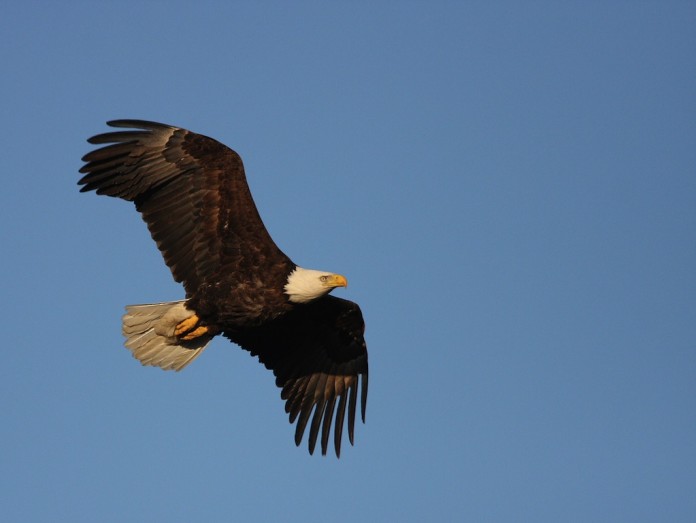Along with bright green leaves and warmer weather, the return of many birds to my yard is a welcome sight. Even more exciting is spotting a powerfully built bald eagle, its large form perched in a tree or swooping down to capture some unassuming prey — or even snacking on roadkill, but I choose to block that particular image from my memory.
Ohio eagles
Bald eagles here in Ohio typically lay their eggs and begin to incubate during February and March. The incubation period is roughly between 34 and 36 days. The hatchlings will stay in the nest until their first attempt at flying between 10 and 14 weeks.
The abundance of bald eagle sightings in May is most likely attributed to the feeding schedule in the nest. After the eaglets hatch, the female tends them in the nest and the male brings the food for the first 2 to 3 weeks. Then the female begins feeding the young as well. Together, the adults will bring 4 or 5 prey to the nest each day for the eaglets.
Young eagles
It was just a coincidence that during this time of frequent eagle sightings that my two sons participated in a flying event at the Youngstown Warren Regional Airport in Vienna. The local chapter of the EAA, Experimental Aircraft Association, sponsored an event called Young Eagles Flights.
The EAA is a grassroots movement of people interested in recreational flying. For the Young Eagles program, volunteer pilots provide free flights to interested children between the ages of 8-17. We found the information by chance and jumped at the opportunity for the boys to experience a flight.
Luckily for us, there was a local airport participating, all we had to do was register online. I knew the highlight for the boys would be the flight itself, but I didn’t realize how impactful interactions with the volunteers would be as they shared their passion for aviation and knowledge of airplanes.
Several of the planes were from the Ernie Hall Aviation Museum in Warren, Ohio. Other planes were owned by the pilots volunteering their time for the event. My boys were assigned to fly in a Cessna 172 Skyhawk. As they climbed inside, a C130 roared overhead.
They buckled their seatbelts and put on the headphones just in time for the lesson by their pilot to begin. His enthusiasm drowned out any nervousness. He explained the entire process leading up to their flight.
Once in the air, the higher altitude provided the boys with an eagle’s eye view of the surrounding area. Having grown up fishing in Mosquito Lake, they saw it for the first time from the air. What normally takes 15 minutes to cruise in the fishing boat from the causeway to the boat launch passed in seconds.
Aquatic invaders
What surprised them was their ability in the air to see several large growths of weeds in the water. We are assuming that the weeds they could see from the plane are the same ones that have been damaging boat motors and threatening the lake’s ecosystem in recent years.
The main aquatic invader is Hydrilla verticillata, which is also known as hydrilla, water thyme and Indian star-vine. The problem with hydrilla is that it blocks out sunlight and prevents oxygen production in the water. It also increases water temperature and affects the pH levels.
Native species cannot grow in the conditions created by hydrilla. Thick growths of hydrilla form something like a blanket, trapping fish and disrupting spawning. Another threat to the ecosystem is the Eurasian watermilfoil. In shallow areas of the lake, it grows quickly, also forming thick mats that block sunlight.
Both hydrilla and Eurasian watermilfoil can easily spread throughout the lake threatening the diversity of native plants. The Ohio Department of Natural Resources along with the Ohio EPA are exploring options for eradicating the invasive species in the lake without harming native species or the drinking water supply.
After flying over Mosquito Lake, the boys were able to see other local areas before heading back towards the airport. The ride back was a little bumpier as the boys experienced the effects of thermals during the flight. It was a phenomenal experience for them to learn more about aviation.
Campground exploration
We had reservations to camp at Mosquito Lake State Park campground after their flight. In one day, they were able to see the lake from the air and explore the land around it on foot.
We were impressed with recent renovations to the campground including new shower houses and improved drainage close to the lake. In addition to the natural playground in the woods, a new playground was installed in a central location.
Even among hundreds of campers, early morning bird calls filled the air. We didn’t see another bald eagle, but mourning doves cooed softly and a Northern mockingbird chirped and trilled on repeat. From soaring heights to the quiet calm of early mornings, it was a wonderful weekend close to home.













